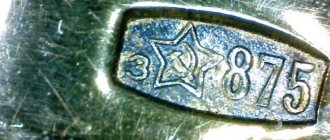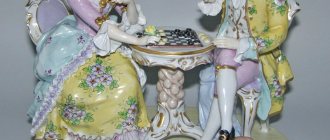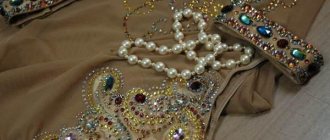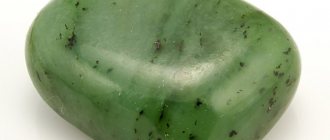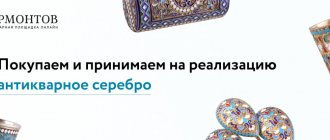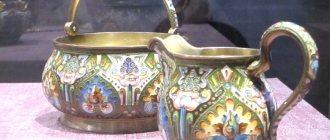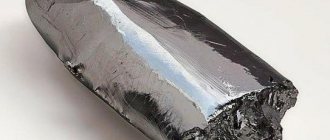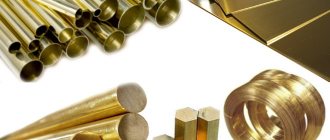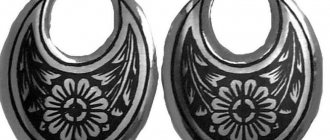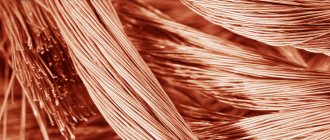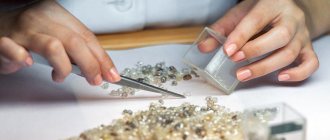Story
Silver spoons appeared in antiquity - in Ancient Greece and Rome. In the Middle Ages, silverware was mainly used by the nobility and the king's court. They became more widespread during the Renaissance. Then an interesting custom arose to give so-called apostolic spoons for christenings. The handles of the spoons were decorated with images of saints, Jesus and the Virgin Mary.
Silver teaspoons
Richer godparents gave a couple of spoons, and eminent and noble birthday people received a full table set for 12 items.
The child was usually given a spoon with the name of the apostle after whom he was named.
Not everyone could afford such a gift. Therefore, the proverb appeared: “He was born with a silver spoon in his mouth.”
The custom of decorating cutlery spread in the Baroque era, when spoons began to be decorated with complex patterns, landscapes and other images began to be applied to them.
In Rus', silver spoons appeared at the end of the first millennium. In 998, Prince Vladimir's squad received spoons as a gift for converting to the Christian faith and abandoning paganism.
In Russia, a spoon was a good gift. It was given not only as a gift, but also in honor of the child’s admission to the gymnasium, and to newlyweds for a wedding. A wealthy family stocked up their daughter's cutlery as a dowry. It was usually passed down from generation to generation.
This material, developed by Pavel P., presents the main distinctive options for applying stamps, markings, and numbering issues for Kalashnikov assault rifles and light machine guns produced in the USSR/Russia.My new book “AK Markings” is a reference guide for the date of production of Soviet Kalashnikov assault rifles of the 1947 Model. The book allows the reader to determine the specific month of production of the AK-47, AK from the very first year of mass production (1949) to the final year of production (1959) according to the Cyrillic letter markings (Russian letters) of the rifle. For the AK Type there is also the year of production, which is determined by the corresponding suffix Cyrillic letter.
All information is based on the original declassified orders, copies of which are partially provided in the book. In addition to the AK themselves, information is also provided on the markings of their respective rifle crates (containers), crates of spare parts and accessories.
The book provides a consistent, year after year description of markings and text translations of the orders and original tables for AK markings. Also in the book are photos of actual markings of the AK for each specific serial production year, and analysis is provided.
Buy book on eBay: https://www.ebay.com/itm/124836328127
The main location of stamps, markings, numbers of Kalashnikov assault rifles of various modifications and Kalashnikov light machine guns of various modifications
The main location of stamps, markings, numbers of Kalashnikov assault rifles of various modifications and Kalashnikov light machine guns of various modifications is the left side of the receiver, mod of the sighting rib block.
The main location of the fire switch markings is on the right side of the receiver, to the right of the AK safety mark.
The main arms factories that produced Kalashnikov assault rifles and Kalashnikov light machine guns:
Izhevsk Machine-Building). The former “Izhevsk Arms Plant” - hereinafter referred to as Izhmash.
Tula arms factory. Since 1993 - OJSC "TOZ" - hereinafter referred to as TOZ .
No. 367 Vyatsko-Polyansky machine-building. Formed in 1940 - hereinafter referred to as VPMZ .
Figure - markings of fire modes from first generation assault rifles (AK-47, AK) to fourth generation assault rifles (AK74M and 100th series)
The basic scheme for reading and interpreting stamps, markings, numbers of Kalashnikov assault rifles of various modifications and Kalashnikov light machine guns of various modifications
AK markings
The assault rifles of the earliest stage of production (1949-51) with stamped receivers (referred to as “AK (AKS) type 1”) had factory markings engraved on the protective coating, which during operation led to the abrasion of traces of these markings. Subsequently, in order to preserve the identification features of the weapon, the lost elements of the factory markings were re-applied using the impact method over the old engravings. This procedure was carried out when repairing machines before storing them for long-term storage. Most often, only the numbers of the serial number and the year were entered, and the year was written formally and may not correspond to the true one. For example, there are assault rifles manufactured in 1949 with the designation “1947,” which could not have happened under any circumstances, since Kalashnikov assault rifles were not mass-produced at that time. Such confusion could arise either due to the loss of readability of the original mark, or due to the negligence of the performer.
The picture shows the markings of the year of manufacture and the machine gun number of the gross AK-47 (AK of the first years of manufacture).
Lack of manufacturer's markings.
The absence of manufacturer's markings is typical for Kalashnikov AK assault rifles produced in 1949-1951.
On AK and AKS assault rifles with milled receivers (referred to as “AK (AKS) type 2”) from 1951 to 1952, the main elements of the factory markings were engraved. From the second half of 1952, the main mark along with the year of production began to be applied with an imprint, and the series and number of machine guns were applied with impact stamps, while the method of marking the translator’s positions remained the same - engraving. Only since 1953 did the designations of the translator’s positions (“AV-OD”) begin to be stamped. The picture shows the markings of the year of manufacture and the machine number of the gross non-lightweight AK.
Letter index designating the year of manufacture.
With the advent in 1955 of machine guns with lightweight milled receivers (referred to as “AK (AKS) type 3”), the fire mode translator was fixed no longer by two spherical recesses, but by two marks with the corresponding designations. As for the designation of the dates of production of weapons, then, presumably, since 1955, the coding of the year of manufacture with a letter was introduced, while their numerical designation was abolished.
The picture shows the markings of the year of manufacture and the machine number of the gross lightweight AK.
The letter index designating the year of manufacture is typical only for Kalashnikov AK assault rifles produced in 1955-1959.
An example of such a designation:
- 1 — Marking of the manufacturer Izhmash.
- 2 - Letter index of the year of production of the machine gun, located after the number. In this case, the year of production of the AK is 1957.
- 3 - individual weapon number.
Table of correspondence between the year of AK production and the letter index:
| 1955 | D |
| 1955 | AND |
| 1956 | TO |
| 1957 | L |
| 1958 | M |
| 1959 | R |
An example of markings for an AK assault rifle manufactured in 1958:
AKM markings
With the start of mass production of the AKM family of assault rifles, it was decided to abandon the letter designation of the year and return to the numerical one. However, the AKM pilot production batches of 1959 still had the letter designation of the year of manufacture (“P”). This method was not used further, and the machines had a direct indication of the production date. The picture shows the markings of the year of manufacture and the number of the gross AKM (AKMS) assault rifle produced by Izhmash.
The picture shows the markings of the year of manufacture and the number of the gross training AKM (AKMS) machine gun produced by Izhmash.
The numbering and marks of machine guns were approved by the First Departments of factories (departments for the protection of state secrets) in order to record and preserve state secrets of the number of machine guns produced. Where the first letter denoted the release series, and the second letter denoted the month of release. In this case, the letters were chosen randomly, and not sequentially, the branding order was updated every year by the Plant Director and was classified as Top Secret.
AKM assault rifles were produced simultaneously at two factories (IzhMash and TOZ) until 1977. Initially, both factories assigned numbers to machines in the form of a “series-number” combination; since 1973, machines produced by the IzhMash plant began to have only a digital number without letter series. TOZ's transition to a fully digital serial number occurred in 1975. All of the above marks were applied by impact to the receiver liners. It is interesting that the Izhevsk machine guns had the mark of the plant and the year of its manufacture, made on the insert with an imprint, and TOZ until the first half of 1969 applied them using impact stamps and only from the second half of 1969 switched to an imprint. Training machine guns produced at IzhMash could have factory markings that differ in the method of application from the marks of combat machine guns. This suggests that the production of training machine guns was carried out at the initial stage of production, and not as a result of the conversion of combat machine guns. The picture shows the markings of the year of manufacture and the number of the gross AKM assault rifle produced by the Tula Arms Plant.
AK74 assault rifles
AK74 assault rifles produced in 1974 (which until 1977 were produced only in Izhevsk) had a number of factory markings characteristic of pre-production samples. In particular, the main mark had the letter series “PH”, which was assigned to experimental 5.45 caliber assault rifles starting in 1972. Since 1975, serial numbers on AK74 assault rifles have taken on the form of a six-digit number. In 1980, another change occurred in the form of recording the year of manufacture of weapons - it began to be designated by the last two last digits of the twentieth century. In 1981, machine numbers became a seven-digit group of numbers. The picture shows the markings of the year of manufacture and the number of the gross AK74 (AKS74) assault rifle produced by Izhmash.
In Tula, the AK74 assault rifle was produced for only four years, from 1978 to 1981. Moreover, the year of manufacture had a complete form from 1978 to 1980, and 1981 was indicated by the two-digit number “81”. After this, the production of AK74 assault rifles in Tula ceased and they were replaced in production by AKS74U assault rifles. Figure - markings of the year of manufacture and the number of the gross AK74 assault rifle produced by the Tula Arms class=»aligncenter» width=»1314″ height=»782″[/img] The AKS74U assault rifle was put into service in 1979, but its production began in Izhevsk in 1978 and continued until 1981, after which in 1982 it was moved to Tula. There, the AKS74U assault rifle was produced until 1993, after which it was discontinued. The form of factory marking on these machines remained unchanged from the initial to the final stage of their production. The exception was training machines that had a two-digit letter series and a four-digit number. The picture shows the markings of the year of manufacture and the number of the gross AKS74U machine gun.
Figure - markings of the year of manufacture and number of the AKS74U gross training machine gun produced by the Tula Arms class=»aligncenter» width=»1234″ height=»764″[/img]
4th generation assault rifles (AK74M and “hundredth” series)
In 1991-92, IzhMash made a transition in production from the AK74 (AK74N) and AKS74 (AKS74N) line of assault rifles to a unified set of “100 series” assault rifles. The very first of the serial assault rifles, which were the AK74M assault rifles, differed little from their folding predecessors AKS74N. And the numbering of new machines continued the count started in previous years. At the time of the start of production of Kalashnikov assault rifles “100 series”, the number of copies produced exceeded 8 million. The year of production of the assault rifles along with the IzhMash mark, starting with the AKM assault rifles, was initially applied on the left side of the receiver liner, and serial numbers were assigned to the weapons at the final stage of its manufacture. Accordingly, every new year it was necessary to update the print with its designation to the current one. With the advent of the 21st century, this principle was changed in favor of a simpler designation: machine numbers began to have an eight-digit number after the brand, in which the first two digits indicated the year of production. Since 2009, the method of applying the digits of the license plate has also changed - it began to be formed by repeated impact of the impact head of a special marking machine. The picture shows the markings of the year of manufacture and the machine number of the 4th generation gross machine guns (AK74M and the “hundredth” series) produced by Izhmash.
RPK (RPKS) machine guns
RPK machine guns produced in 1959-1962 were distinguished by factory markings, in which there was significant variability in the groups of designations applied - they changed places twice a year. The 1962 machine guns have three combinations of markings. Since 1963, the marks took on a single form, which remained unchanged over many years of production of machine guns of both 7.62 mm and 5.45 mm calibers. The picture shows the markings of the year of manufacture and the machine gun number of the RPK (RPKS) gross machine guns produced by VPMZ.
If on AKM assault rifles in the mid-70s there was a transition from an alphanumeric to a numeric factory numbering scheme, then in the case of the RPK and RPK74 machine guns, the abandonment of letter series never occurred - these samples still had alphanumeric serial numbers . The letter series was separated from the number by a hyphen, which was typical only for RPK machine guns (RPK74), but was not used on machine guns. Only in 1985, on RPK74 machine guns, the hyphen stopped separating the series and number of the weapon. The marks remained the same on the RPK 200 series machine guns. The picture shows the markings of the year of manufacture and the machine gun number of the gross machine guns RPK74 (RPKS74) produced by VPMZ.
Repair markings
After Kalashnikov assault rifles and Kalashnikov light machine guns enter repair shops (factories, RAV services, etc.), a marking of repair work is engraved on the weapon. Markings can be applied to both metal parts of the weapon and wooden (plastic) parts. It is basically an equilateral quadrangle - a square.
Various examples of repair markings:
Hollow (empty) square
Diagonally crossed square
Vertically crossed out square
Stamps on bringing AKM assault rifles to normal combat
Information is presented in the material: Stamps on bringing AKM assault rifles to normal combat after a major overhaul based on the reorgan. Description, photos
Markings of training (deactivated) weapons
Markings of training (deactivated) weapons are applied to household items, which are dimensional models of the corresponding weapons, made by deactivating (impossibility of firing) the main parts of the weapon (in accordance with the current legislation).
Examples of markings:
The letters UC are markings for training Kalashnikov assault rifles and Kalashnikov light machine guns.
The inscriptions MMG, MGV, “MMG AKM”, MAKET, painted or engraved on metal parts of the weapon are markings of deactivated weapons.
Pictures and text used:
- Collection of Pavel Ptitsyn, ak-info
- Podgornov Konstantin, 2022, https://gunsforum.com/topic/2409-osnovnye-kleyma-i-markirovki-avtomatov-i-ruchnyh-pulemetov-kalashnikova/
Which spoons are valued?
First of all, sets are valued, not isolated copies. Of course, a spoon with a master's name, decorated with a monogram, also has a high cost. But not only millionaires can afford to buy them. The cost of devices is in the thousands, not millions of dollars.
In 1912, at a Christie's auction, a pair of Faberge spoons went for $8,000. The spoon, made by Fedor Ruckert, sold for $12,500.
Silverware from German jewelers is prized throughout the world. The Robbe&Berking company supplies instruments to the palaces of oil sheikhs and to the court of the Queen of Great Britain. The companies Robert Freund, Franz Schnell Halle, Herbert Zeitner became famous.
English tableware from William Suckling, Ridley&Hayes and many other craftsmen is prized. Jewelers from Denmark also became famous for their silver products.
Among the masters from Russia, the firms of the Grachev brothers, Sazikov, Ovchinnikov, Khlebnikov and, of course, Faberge are famous.
Many of them were suppliers to the imperial court. This was honorable and prestigious; usually the products of these companies were branded with a special sign.
How much do the devices of these masters cost in Europe? The prices cannot be called exorbitant. For example, a gilded spoon, the handle of which is decorated with an image of the Virgin and Child, by the famous master A. Michelsen (Denmark) is valued at $230. It was made in 1916. Prices for this master's devices range from $50 to $600 per unit.
Antique silver spoons of the 19th-18th centuries, made by famous masters, may cost a little more. For example, a set of silverware (six forks and spoons) - manufactured in 1855 - by jeweler Hippolyte Thomas in one of the online antique stores is offered for one and a half thousand dollars. The devices are decorated with the owner’s monogram and look great; their weight is more than a kilogram.
Soviet Silver Table
In 1918, the factory of I.P. Khlebnikov's supplier to His Imperial Majesty was nationalized.
From the moment of nationalization until 1922, the refining production of precious metals was restored using the preserved factory equipment.
After the end of the Civil War, the country found itself under a trade and economic blockade. It was decided to use the competence of the factory personnel in working with precious metals to establish the production of parts, products and equipment for industrial use, which the economy of Soviet Russia urgently needed.
In 1922, the main enterprise of the factory was transformed into the Moscow Platinum Plant. The main type of products produced at the plant were industrial products made of platinum, as the name of the plant actually indicates.
The enterprise mastered the production of products for the radio engineering (grids and cathodes for radio tubes), chemical (crucibles, catalysts, etc.), electrical (contact groups for starters and relays, solders, etc.) industries.
The plant received concentrate as raw material from processing plants located in the Ural region. The composition of the concentrate, along with platinoids (platinum, palladium, rhodium, etc.), also included silver in significant concentrations. After the processes of isolating platinum group metals in their pure form, silver accumulated in the form of waste, which was later processed not only into alloys for technical use, but also into alloys for jewelry.
Before the revolution, the main specialization of Khlebnikov’s workshops and factory was the production of silver tableware and jewelry made of precious metals. Obviously, it was decided to use some of the surviving equipment to resume the production of tableware. A core of specialists has also been preserved, possessing technologies for the production of cutlery and tableware (workshop workers who were unemployed and former private jewelers).
The post-war devastation and difficult economic conditions of the first years of Soviet power did not contribute to the population purchasing silver tableware in any noticeable quantities. Therefore, in the segment of goods for retail sale to the population, tableware was mainly produced from cupronickel, nickel silver and silver-plated brass. Such devices were branded with the following marks: “BEL. MET.", "MET" and "BM".
At the same time, objects appeared and became very popular among the population, the design of which was based on the so-called “propaganda” theme (symbols and slogans of the new government).
Items with a “propaganda” theme were produced in fairly large quantities. You can still find a variety of cigarette cases, glass holders, vases, jugs and other items with such symbols.
In the first half of the 20s of the last century, silver products were produced in limited editions. Sometimes such devices were made to order and ended up in private collections.
Most silverware from this period is what is known as "plain" silverware. These are devices on which there is no drawing at all.
As the national economy of the country was restored, the income of the population began to grow and
By the end of the 20s of the last century in the USSR, certain social groups (mainly Nepmen, labor intelligentsia, administrative party and economic nomenklatura) began to demand luxury - jewelry made of precious metals and tableware made of silver.
The luxury goods remaining in the country began to be in short supply and, responding to the ever-increasing demand of buyers for products made of precious metals, the Moscow Platinum Plant, in parallel with the production of tableware from cupronickel, significantly increased the production of various silverware and utensils.
Products that were produced before the revolution in the workshops of Khlebnikov and other famous jewelers of the Russian Empire were taken as prototypes.
Most of the designs were made in the neoclassical style (bows, wreaths, ribbons, flowers, etc.). They also resumed the production of devices with designs popular during the imperial period, such as “flame”, “sphinxes”, “torch”, etc.
In the second half of the 30s of the twentieth century, the plant began mass production of silverware.
The most popular among buyers were devices with a “flame” pattern. Consumer demand for cutlery of this design was mainly due to the fact that almost the entire line of cutlery types was produced: tea spoons, dessert spoons and tablespoons; dessert, table forks and knives, as well as ladles, spatulas and some other serving utensils.
From the first years of work until the beginning of the Great Patriotic War, it was practically the only large enterprise in the entire country that mass-produced silverware.
The figure in the form of a table presents information about the name of the plant, its departmental subordination at different periods of its history, as well as a description and photo of the marks on silverware.
The following types of name stamps are known on cutlery manufactured by us (the stamps are presented in the chronological order of their appearance):
- "MOSCOW PAYMENT" (pos. 1; 3);
- "MPZ" (item 2; 4);
- “MOSTORG.” IZG. M.P.Z.” (pos.5);
- “Z-D PLATINOPRIBOR” (item 6);
- “PLATINOPRIBOR” (item 7);
- “PLATINOPRIBOR” stamp is made in the form of a fragment of a product design (item 8);
- “PLATINO” (item 9);
- “Z-D MELKHIZ” (pos. 11);
- “Sz” (pos. 12);
Please note that devices with the name stamp “MOSK.PLAT.ZAV.” and “MPZ” are found in combination with different types of hallmarks, both spool type - 84º, and with metric hallmark - 875º, which appeared on products in 1927. Other types of name marks on the factory's products are found only in combination with a metric type assay mark - 875º.
It is quite rare to find silverware with the mark “MOSTORG. IZG. M.P.Z.” (pos. 5). Briefly about the history of the origin of this mark.
The Mostorg Trust, one of the first Soviet trade and purchasing enterprises, was created in 1921. During the years of the NEP, especially in the last years before its abolition, the population became actively interested in jewelry made of precious metals. In connection with this, in 1929, jewelry trade was organized in several department stores of the trust. In 1931, the significantly expanded trust was divided and renamed GorMostorg. Obviously, the brand “MOSTORG. IZG. M.P.Z.” appeared as a result of the trust ordering silver cutlery from the Moscow Platinum Factory.
Thus, silver tableware with the mark “MOSTORG. IZG. M.P.Z.” could have been manufactured at the plant between 1929 and 1932.
In 1932, the Moscow Platinum Plant was renamed the Platinopribor Plant.
Also interesting is the fact that, extremely rarely, but still there are devices not of the generally accepted 875, but of 800 standard. The appearance of such products can be explained by the fact that the plant received very significant volumes of recyclable materials from precious metals collection points, as well as from the Torgsinov network. Receivers did not always carefully check the products handed in by the public. Sometimes items clad in silver and even made from cupronickel and nickel silver slipped through. At the factory, such products also sometimes ended up in the smelting furnace as scrap silver and, as a result, the alloy had a purity lower than 875º.
When testing such products, a discrepancy with the generally accepted standard was revealed, and in most cases such products were subjected to re-melting to bring the alloy sample to normal. Sometimes such products were nevertheless “saved” from being melted down and stamped with an assay mark with a lower hallmark value, namely 800º (item 10).
As a rule, the “right to life” was given to products with high labor intensity of production, which included most types of tableware. Quite rarely, among products with an 800º hallmark, you also come across devices that are cheap in terms of manufacturing cost, such as spoons.
Industrial products from precious metals and their alloys were extremely important for the country’s economy, therefore, in the first months of the Great Patriotic War, the plant’s equipment and personnel were evacuated to the site of the Sverdlovsk plant for processing special alloys (“Sverdlovsk OCM plant”).
But already in 1942 the plant returned to Moscow again and produced products only for military purposes. In 1944, the plant was transferred to the Goznak Administration, which also included the Moscow Mint (MMD). At this time, in addition to the production of military products, the plant also launched the production of state awards, such as: the Order of the Red Star, the Order of the Patriotic War 2 degrees and Glory 3 degrees.
Immediately after the victory in the Second World War, all the country’s forces and resources were concentrated on the speedy restoration of the national economy destroyed by the war, so the production of silver cutlery at the plant was not resumed.
In 1945 at . and the plant was completely reoriented to the development and production of parts, assemblies and equipment for the rocket and electronics industries. The plant’s specialists also participated in the implementation of the “nuclear project”.
In 1946, it was decided to separate the existing production capacity at the plant for the production of tableware products into a separate enterprise - the Cupronickel Silver Products Plant .
On the products of the newly formed enterprise, the mark “Z-D MELKHIZ” (item 11) appeared - an abbreviation for “Factory of Cupronickel Silver Products”. The plant owes its name to the alloy of copper, nickel and zinc - “nickel silver”, which was widely used for the manufacture of various tableware.
Products made from this alloy were either branded with the additional mark “MNTs”, or the letters MNTs were an integral part of the “name holder” mark.
For obvious reasons, in the first post-war years, the population's demand for silverware was very small. The volumes offered in the Soyuzuvelirtorg chain of stores were quite sufficient. During the Second World War, the population of the USSR handed over a large amount of jewelry and silver tableware to state collection points for precious metals for the needs of the front. The cheapest part of these products and devices was restored and offered for sale to the public through the Soyuzyuvelirtorg chain of stores.
In the first years after its formation, it produced mainly tableware from cupronickel, gradually increasing the volume of production of silverware as demand from the country's population recovered.
In the second half of the 50s of the twentieth century, the plant mainly switched to the production of special equipment and parts made of precious metals, and the production of jewelry made of precious metals was also mastered and established. The share of tableware products made of cupronickel and silver was already a small share of the plant’s production.
In 1959 it was renamed the Moscow Plant of Special Alloys (MZSS). In the 60s of the twentieth century, the plant did not produce silverware, and only in 1973, as part of the program for the production of “consumer goods”, the production of silver spoons was prepared and launched as the least labor-intensive tableware in the manufacture.
It was during this period that the “ Sz ” stamp (pos. 12) appeared on the factory’s silver spoons. As a prototype, it was decided to use the once very popular among buyers cutlery with the “Kyiv” pattern, which was produced at the Kiev Cutlery and Crockery Plant named after. Dzerzhinsky" in the 50s of the twentieth century.
Coffee, tea and tablespoons with the “Kyiv” pattern were produced by the plant for four years until 1976 inclusive. By that time, at the Kiev plant itself, devices with such a pattern were no longer produced (series with the “oak”, “Faberge” and “chestnut” patterns went into production).
Thus, in 1976, now finally, the history of the production of silverware at the famous and its subsidiaries was completed.
Later, in the “consumer goods” segment, the plant produced only limited quantities of jewelry.
Samples and hallmarks
Nowadays, sterling silver spoons are the most valuable. This is what 925-grade metal is called. Devices of 999 standard are not found, since pure metal is easily subject to deformation: it bends, breaks, and is scratched.
925 standard spoons are often coated with gold and enamel. They are in excellent preservation and appearance. In France, products of 900 and 950 samples were made. Silver that has been decorated with enamel is often 916 in metric measurement.
What is 84th silver standard? You can often find this sample on antique spoons from Russia. The ancient spool measure of precious metals was used until 1927. This sample corresponds to the 854th in metric measurement.
Mark on silver cutlery
